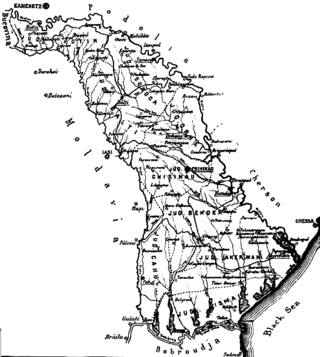The Landsmannschaft der Buchenlanddeutschen (i.e. "Territorial Association of Bukovina Germans" or "Homeland Association of Bukovina Germans") was an organization of German refugees expelled from their homes in Bukovina and Bessarabia after World War II. These groups of ethnic Germans are collectively known as Bukovina Germans (German : Buchenlanddeutschen or Bukowinadeutschen) and Bessarabia Germans (German : Bessarabiendeutschen) respectively. It ceased its activity in 2020. The organization was based in the city of Augsburg, Swabia, Bavaria, south-eastern Germany, and was founded in 1949.
The 41 județe and the municipality of Bucharest comprise the official administrative divisions of Romania. They also represent the European Union' s NUTS-3 geocode statistical subdivision scheme of Romania.

The Kingdom of Romania was a constitutional monarchy that existed from 13 March (O.S.) / 25 March 1881 with the crowning of prince Karl of Hohenzollern-Sigmaringen as King Carol I, until 1947 with the abdication of King Michael I and the Romanian parliament's proclamation of the Romanian People's Republic.
The Kingdom of Romania, under the rule of King Carol II, was initially a neutral country in World War II. However, Fascist political forces, especially the Iron Guard, rose in popularity and power, urging an alliance with Nazi Germany and its allies. As the military fortunes of Romania's two main guarantors of territorial integrity—France and Britain—crumbled in the Fall of France, the government of Romania turned to Germany in hopes of a similar guarantee, unaware that Germany, in the supplementary protocol to the 1939 Molotov–Ribbentrop Pact, had already granted its blessing to Soviet claims on Romanian territory.

Chernivtsi Oblast, also referred to as Chernivechchyna (Чернівеччина), is an oblast (province) in western Ukraine, consisting of the northern parts of the historical regions of Bukovina and Bessarabia. It has an international border with Romania and Moldova. The region spans 8,100 square kilometres (3,100 sq mi). The oblast is the smallest in Ukraine both by area and population. It has a population of 890,457, and its administrative center is the city of Chernivtsi.

The Moldavian Soviet Socialist Republic or Moldavian SSR, also known as the Moldovan Soviet Socialist Republic, Moldovan SSR, Soviet Moldavia, Soviet Moldova, or simply Moldavia or Moldova, was one of the 15 republics of the Soviet Union which existed from 1940 to 1991. The republic was formed on 2 August 1940 from parts of Bessarabia, a region annexed from Romania on 28 June of that year, and parts of the Moldavian Autonomous Soviet Socialist Republic, an autonomous Soviet republic within the Ukrainian SSR.

The historical regions of Romania are located in Central, Southeastern, and Eastern Europe. Romania came into being through the unification of two principalities, Wallachia and Moldavia in 1862. The new unitary state extended over further regions at various times during the late 19th and 20th centuries, including Dobruja in 1878, and Transylvania in 1918.

The Soviet deportations from Bessarabia and Northern Bukovina took place between late 1940 and 1951 and were part of Joseph Stalin's policy of political repression of the potential opposition to the Soviet power. The deported were typically moved to so-called "special settlements" (спецпоселения).

The Germans of Romania represent one of the most significant historical ethnic minorities of Romania from the modern period onwards.

The Hertsa region, also known as the Hertza region, is a region around the town of Hertsa within Chernivtsi Raion in the southern part of Chernivtsi Oblast in southwestern Ukraine, near the border with Romania. With an area of around 304 km2 (117 sq mi), it has a population of about 32,300 people, 93% of whom are ethnic Romanians.

Between 28 June and 3 July 1940, the Soviet Union occupied Bessarabia and Northern Bukovina, following an ultimatum made to Romania on 26 June 1940 that threatened the use of force. Those regions, with a total area of 50,762 km2 (19,599 sq mi) and a population of 3,776,309 inhabitants, were incorporated into the Soviet Union. On 26 October 1940, six Romanian islands on the Chilia branch of the Danube, with an area of 23.75 km2 (9.17 sq mi), were also occupied by the Soviet Army.

Nicolae Ciupercă was a Romanian general, born in Râmnicu Sărat. He served during World War I and World War II under the command of Alexandru Averescu and then Ion Antonescu, but would retire from a military life in 1941 over strategy disagreements with Antonescu. He also served as Minister of National Defense in 1938–1939.

The General Jewish Labour Bund in Romania was a Jewish socialist party in Romania, adhering to the political line of the General Jewish Labour Bund. Founded in 1922, shortly after the establishment of Greater Romania, it united Jewish socialists in Bukovina, Bessarabia and the Romanian Old Kingdom. Standing for the lay wing of the Jewish representative movement, the Romanian Bund had atheistic leanings and offered an alternative to the mainstream Jewish organization. Like other Bundist groups, but unlike the Marxist-inspired Poale Zion bodies of Bessarabia, it rejected Zionism.

The Bessarabian question, Bessarabian issue or Bessarabian problem is the name given to the controversy over the ownership of the geographic region of Bessarabia that began with the annexation of the region by the Russian Empire from the Romanian principality of Moldavia in 1812 through the Treaty of Bucharest and which continued with the independence and union of Bessarabia with Romania in 1917, the occupation and annexation of the region by the Soviet Union in 1940, and the dissolution of the Soviet Union that caused the emergence of two new states that each controlled parts of Bessarabia: Moldova and Ukraine.
Jahn Cernăuți was a German football club from Czernowitz, Bukovina. The club became regional champions in 1924, 1925, and 1934 and participated in three seasons of Divizia A. The club ceased to exist before the end of World War II.
The union of Bukovina with Romania was declared in 28 November 1918, being officially recognized by the international community in 1919 and 1920.
The Landsmannschaft der Bessarabiendeutschen is an organization of Bessarabia German refugees expelled from their homes after World War II.

The territorial evolution of Romania includes all the changes in the country's borders from its formation to the present day. The precedents of Romania as an independent state can be traced back to the 14th century, when the principalities of Moldavia and Wallachia were founded. Wallachia during its history lost several portions of its territory, either to the Ottomans or the Habsburgs. However, this land would be later essentially recovered in its entirety. Moldavia, on the other hand, suffered great territorial losses. In 1774, the Habsburgs invaded Bukovina and annexed it one year later, and in 1812, the Russian Empire took control of Bessarabia. Both territories were later exposed to powerful colonization policies. The principalities declared unification in 1859 as the Principality of Romania. This new state sought independence from the Ottoman Empire's vassalage, and in 1878, it fought a war against it alongside Russia. However, the latter would annex Southern Bessarabia, which was recovered decades before. Romania received Northern Dobruja as compensation, and would wage a war for the southern part against Bulgaria in 1913.

The Bukovina Governorate was an administrative unit of Romania during World War II.

The Bessarabia Governorate was an administrative unit of Romania during World War II.
The Bukovinian Ukrainian Self-Defense Army(BUSA) (Ukrainian: Буковинська українська самооборонна армія, romanized: Bukovynska ukrainska samooboronna armiia) was an underground armed formation consisting mainly of Ukrainians from Bukovina and Bessarabia during World War II. Its goal was to create an Independent Conciliar Ukrainian State.